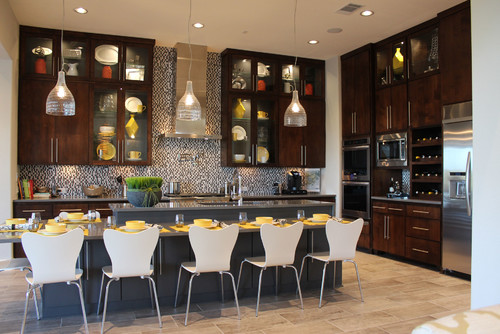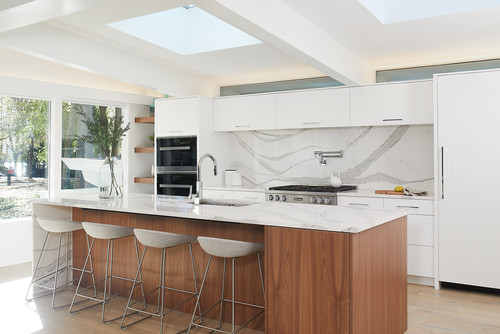

Slab Cabinet Doors Basics and Pros and Cons
In recent years, modern slab cabinet doors have become increasingly popular in kitchen designs. These sleek, contemporary doors provide a minimalist aesthetic that appeals to many homeowners. In this blog, we will delve into the basics of slab cabinet doors, including their pros and cons.
The Basics of Slab Cabinet Doors
Slab cabinet doors, also known as flat panel cabinet doors, have become a popular choice in contemporary kitchen design due to their minimalist and streamlined appearance. This type of cabinet door is characterized by its smooth, unadorned surface that offers a sleek and modern look for your kitchen. In this section, we will explore the essential features of slab kitchen cabinets.
A. Construction and Design
Slab cabinet doors are constructed from a single, solid panel without any raised or recessed detailing. The simplicity of their design allows slab kitchen cabinets and slab cabinets kitchen to blend seamlessly with various interior design styles, particularly modern and minimalist spaces. Flat panel cabinet doors can also complement more eclectic or transitional designs, offering a clean and uncluttered backdrop for other decorative elements in your kitchen.
B. Material Options
There is a wide range of material options available for kitchen cabinet slab doors, which can significantly impact the look, feel, and durability of your flat panel kitchen cabinets. Some of the most common materials used for slab kitchen doors include:
- Solid wood: Offers a warm and natural appearance, with a variety of wood species to choose from. It is also strong and durable but may be prone to warping in humid environments.
- Medium-density fiberboard (MDF): A budget-friendly and stable option that can be painted or laminated for a variety of finishes. However, it may be less durable than solid wood or plywood.
- Plywood: Composed of layers of wood veneer, plywood offers a balance of strength and stability, making it a popular choice for slab cabinet doors.
- Laminate: A synthetic material that is easy to maintain and can mimic the appearance of wood or other finishes. It is less susceptible to warping but may be more prone to chipping or scratching.
C. Joinery Techniques
The joinery techniques used in the construction of slab cabinet doors can impact the overall quality and longevity of your flat panel kitchen cabinets. Some common joinery methods for slab kitchen cabinets and slab cabinets kitchen include:
- Butt joint: This simple joinery technique involves connecting two pieces of material at a right angle, often secured with glue, nails, or screws. While this method is relatively easy to execute, it may be less stable than other techniques.
- Dado joint: A dado joint involves cutting a groove into one piece of material and fitting another piece into the groove. This technique offers increased stability and strength compared to butt joints.
- Mortise and tenon joint: This classic woodworking technique involves fitting a tenon (a protruding piece of wood) into a mortise (a corresponding hole) to create a strong and stable connection. Mortise and tenon joints are more time-consuming to create but can provide a long-lasting and secure connection for your slab cabinet door.
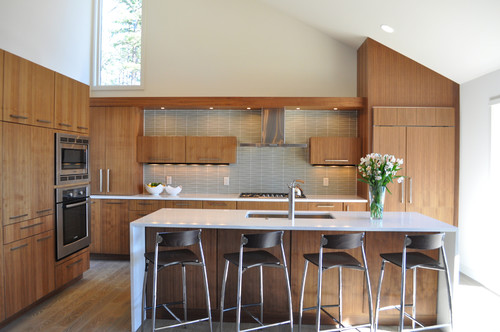
Materials for Slab Cabinet Doors
Choosing the right material for your slab cabinet door is crucial in determining the overall appearance, durability, and maintenance requirements of your flat panel kitchen cabinets.
A. Solid Wood
Solid wood is a popular choice for slab cabinet doors due to its natural warmth, beauty, and durability. Different wood species offer unique grain patterns, colors, and textures, allowing you to create a customized look for your slab kitchen cabinets and slab cabinets kitchen.
Advantages:
- Timeless appeal: Wood offers a classic and versatile look that can complement various design styles.
- Durability: High-quality solid wood doors can withstand years of use without significant wear.
- Repairable: Scratches, dents, or other damage can often be sanded and refinished.
Disadvantages:
- Cost: Solid wood kitchen slab doors can be more expensive than other materials.
- Susceptibility to warping: Wood may warp or expand in humid environments, potentially causing issues with alignment and functionality.
B. Medium-Density Fiberboard (MDF)
MDF is an engineered wood product made from compressed wood fibers and resin, offering a budget-friendly alternative to solid wood for slab cabinet doors. It is known for its smooth surface, making it an excellent option for painted finishes.
Advantages:
- Affordability: MDF is typically less expensive than solid wood or plywood.
- Stability: MDF is less prone to warping or expansion than solid wood.
- Smooth surface: The lack of grain makes MDF an ideal choice for painted finishes.
Disadvantages:
- Durability concerns: MDF may be more susceptible to damage from moisture or heavy use compared to solid wood or plywood.
- Heaviness: MDF is denser and heavier than solid wood, which may require stronger hardware and support.
C. Plywood
Plywood is an engineered wood product made from layers of wood veneer glued together under pressure. It is a popular choice for slab cabinet doors due to its strength, stability, and versatility.
Advantages:
- Stability: Plywood is less likely to warp or expand compared to solid wood, making it a reliable choice for kitchen slab doors.
- Strength: The layered construction of plywood offers increased strength and durability.
- Versatility: Plywood can be stained, painted, or laminated for various finishes.
Disadvantages:
- Cost: High-quality plywood can be more expensive than MDF but is generally less expensive than solid wood.
- Edge appearance: The layered edges of plywood may require edge banding or additional finishing for a polished look.
D. Laminate
Laminate is a synthetic material made from layers of paper or fabric impregnated with resin and bonded together under heat and pressure. It offers a durable and low-maintenance option for slab cabinet doors, with a wide range of colors and finishes available.
Advantages:
- Low maintenance: Laminate surfaces are easy to clean and resist stains, scratches, and moisture.
- Affordability: Laminate is often less expensive than solid wood or high-quality plywood.
- Variety of finishes: Laminate can replicate the appearance of wood, stone, or other materials, offering a range of design possibilities.
Disadvantages:
- Durability concerns: Laminate may be more prone to chipping or cracking than solid wood or plywood.
- Limited repair options: Damaged laminate surfaces cannot be sanded or refinished like wood.
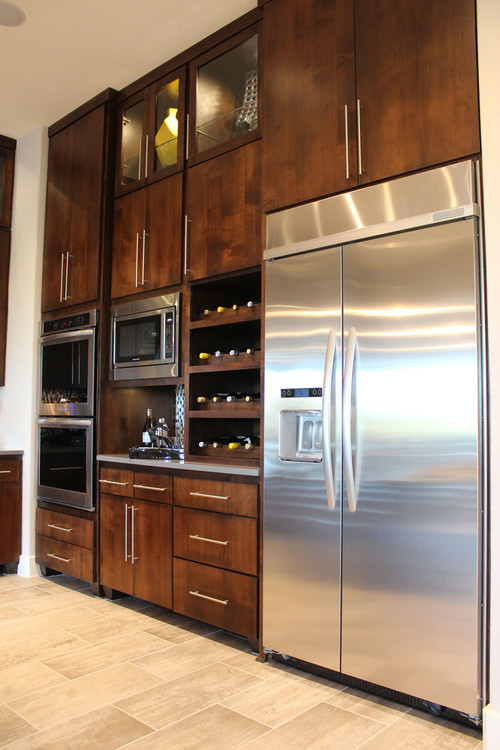
Pros of Slab Cabinet Doors
Slab cabinet doors, also known as flat panel cabinet doors, are a popular choice for many homeowners due to their modern and minimalist design. In this section, we will discuss the advantages of incorporating flat panel cabinet doors and flat panel kitchen cabinets into your kitchen design.
A. Contemporary Aesthetic
One of the most significant advantages of kitchen slab doors is their sleek, contemporary appearance. The clean lines and unadorned surfaces create a minimalist aesthetic that works well in modern homes. Flat panel cabinet doors can also complement various design styles, from industrial to Scandinavian, offering a versatile and visually appealing option for your kitchen.
B. Easy Maintenance
The smooth surface of slab cabinet doors makes them easy to clean and maintain. Without any intricate detailing or grooves, dirt and grime have fewer places to accumulate. This can make slab kitchen cabinets and slab cabinets kitchen an attractive option for busy households, as a simple wipe down with a damp cloth is often enough to keep them looking fresh and clean.
C. Space Enhancement
Flat panel cabinet doors can create the illusion of a larger and more open space in your kitchen. Their minimalist design prevents them from visually overwhelming the room, which can be especially beneficial in smaller kitchens or open-concept living areas. By incorporating slab kitchen cabinets and slab cabinets kitchen, you can achieve a spacious and airy feel in your home.
D. Customization Options
Though slab cabinet doors are known for their simplicity, they can still offer a wide range of customization options. From various materials and finishes to unique hardware choices, you can tailor your flat panel kitchen cabinets to suit your individual style preferences and design vision. This allows you to create a truly personalized space that reflects your taste and lifestyle.
E. Durability
When constructed with high-quality materials and craftsmanship, slab panel cabinet doors can offer excellent durability and longevity. This makes them a sound investment for your kitchen renovation, as they can withstand the rigors of daily use for years to come. To ensure the longevity of your slab kitchen cabinets and slab cabinets kitchen, it’s essential to select the right materials and work with a reputable cabinet maker.
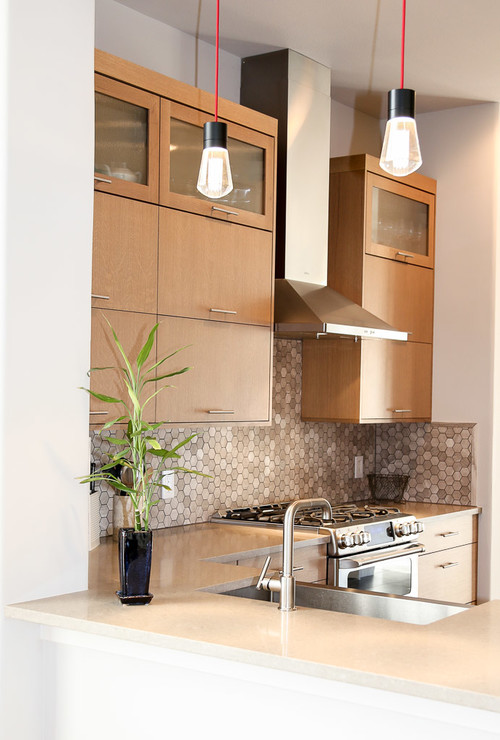
Cons of Slab Cabinet Doors
Despite their many advantages, there are also some drawbacks to using slab cabinet door in your kitchen design. It is essential to consider these potential downsides.
A. Limited Detailing Options
One of the primary drawbacks of slab cabinet doors is their inherent simplicity, which can limit your options for intricate detailing or ornamentation. This minimalism can be an asset in modern and contemporary designs; however, it may not be the best fit for those who prefer more traditional or ornate styles. Flat panel cabinet doors lack the raised or recessed detailing found in other cabinet door styles, which can make them less suitable for certain design aesthetics.
B. Potential for Warping
Depending on the material used, slab panel cabinet doors can be susceptible to warping or bowing over time, particularly in humid environments. Solid wood doors are especially prone to this issue, as they can expand and contract with changes in temperature and humidity. To mitigate this risk, consider using alternative materials, such as MDF or plywood, for your slab kitchen cabinets and slab cabinets kitchen. Additionally, ensure proper installation and sealing to help maintain the shape and integrity of your flat panel cabinet doors.
C. Higher Cost
High-quality slab cabinet doors and flat panel kitchen cabinets can sometimes come at a higher cost compared to their traditional counterparts, depending on the material and construction. Solid wood, for example, can be more expensive than other options like MDF or plywood. To balance your budget and design preferences, consider exploring a range of materials and finishes or mixing slab cabinet doors with other, more cost-effective styles.
D. Fingerprints and Smudges
The smooth surface of slab front cabinets can make them more prone to showing fingerprints, smudges, and other marks, particularly when using darker finishes or high-gloss materials. This may require more frequent cleaning to maintain a pristine appearance. To minimize the visibility of fingerprints and marks, consider opting for matte or textured finishes for your slab kitchen cabinets and slab cabinets kitchen.
E. Potential for Damage
While slab panel cabinet doors can be durable when constructed from high-quality materials, their flat surface can be more prone to visible damage from dents, scratches, or impacts. Repairing such damage can be more challenging on a flat surface compared to a door with raised or recessed detailing, which might help disguise minor imperfections.
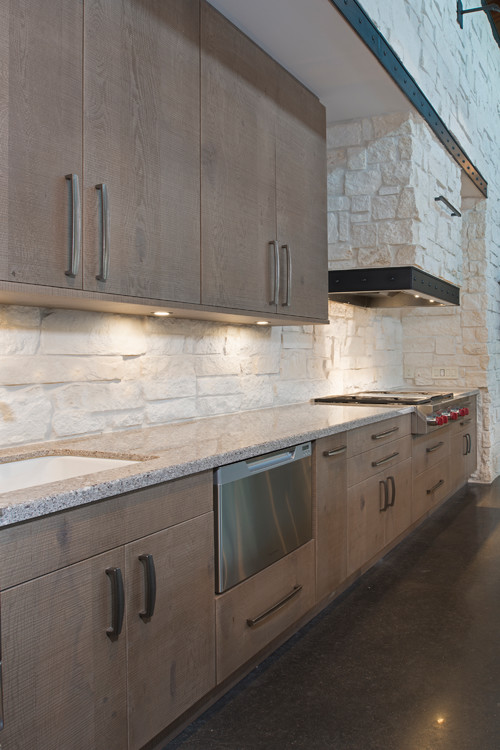
Tips for Incorporating Slab Cabinet Doors in Your Kitchen
Incorporating slab cabinet doors into your kitchen design can create a sleek, modern aesthetic, consider the following tips for a functional and visually appealing space.
A. Balance Simplicity with Texture
While the minimalist design of slab front cabinets offers a clean, contemporary look, it can sometimes feel too stark or cold. To add warmth and interest, consider incorporating textured materials or finishes in your design. This can include using wood grain patterns, matte or textured paint, or even integrating other elements such as a tile backsplash or open shelving to create visual interest.
B. Utilize Creative Storage Solutions
Maximizing storage is crucial for a functional and clutter-free kitchen. Slab cabinet doors provide an excellent opportunity to use creative storage solutions, such as pull-out pantry shelves, built-in spice racks, and custom drawer organizers. These practical features will help maintain the streamlined appearance of your slab kitchen cabinets and slab cabinets kitchen while ensuring that your space remains functional and efficient.
C. Choose the Right Color Palette
The color palette of your kitchen plays a significant role in setting the overall mood and atmosphere. When incorporating slab front cabinets, consider choosing a color scheme that complements the minimalist design. Neutral colors, such as white, gray, or black, can create a modern and sophisticated look, while bold, vibrant hues can add personality and energy to your space. Don’t be afraid to experiment with color, but be sure to strike a balance between simplicity and visual interest.
D. Focus on Lighting
A well-lit kitchen is essential for both function and aesthetics. When designing your kitchen with slab cabinet doors, pay close attention to your lighting plan. Include a combination of ambient, task, and accent lighting to create a welcoming and versatile space. Under-cabinet lighting can be particularly effective in showcasing the clean lines of your flat panel kitchen cabinets while also providing useful task lighting for your countertops.
E. Select Appropriate Hardware
The hardware you choose for your slab cabinet doors can have a significant impact on the overall look and feel of your kitchen. Opt for simple, streamlined hardware that complements the minimalist design of your flat panel cabinet doors. Bar or tab pulls, for example, can create a sleek, modern appearance, while more intricate or decorative options may feel out of place.
Choosing the Right Finish for Slab Cabinet Doors
Selecting the appropriate finish for your slab door cabinets is crucial in achieving the desired look and feel for your kitchen. In this section, we will discuss various finishes for slab door cabinets and offer tips on choosing the right one for your space.
A. Painted Finish
A painted finish allows for a wide range of color options and can provide a smooth, uniform appearance for your slab cabinet doors. High-quality paint can also offer excellent durability and resist chipping, fading, or peeling. To ensure a long-lasting finish, opt for professional application using high-quality paint products specifically designed for cabinetry.
B. Laminate Finish
Laminate finishes offer an affordable and low-maintenance option for slab cabinet doors. They consist of a thin layer of synthetic material applied to the surface of the door, providing a smooth and easy-to-clean surface. Laminate finishes are available in various colors and patterns, including those that mimic the look of natural wood or other materials.
C. Thermofoil Finish
Thermofoil finishes are created by applying a layer of flexible vinyl material to the surface of the cabinet door using heat and pressure. This process results in a smooth and seamless finish that is easy to clean and highly resistant to moisture, making it an excellent option for humid environments. Thermofoil finishes are available in a wide range of colors and patterns, including realistic wood grain textures.
D. Veneer Finish
Veneer finishes consist of a thin layer of real wood or other materials adhered to the surface of the cabinet door. This option allows you to achieve the natural beauty and warmth of wood without the cost and potential warping associated with solid wood slab cabinet doors. Veneer finishes are available in various wood species, grains, and stains, providing numerous options for customization.
E. Stained Finish
A stained finish highlights the natural grain and texture of the wood used for your kitchen cabinet slab doors. Stains are available in a variety of shades, from light and natural to dark and rich, allowing you to customize the appearance of your flat panel kitchen cabinets. To ensure a durable and even finish, it is essential to use high-quality stain products and professional application techniques.
When choosing the right finish for your slab cabinet doors, consider the following factors:
- Aesthetic Preferences: Select a finish that complements your overall kitchen design and personal style preferences.
- Maintenance Requirements: Consider how much time and effort you are willing to invest in maintaining the appearance of your slab kitchen cabinets and slab cabinets kitchen.
- Budget: Factor in the cost of the finish itself and any professional application or installation fees.
- Durability: Choose a finish that will stand up to the wear and tear of daily use and resist damage from moisture, heat, and other environmental factors.
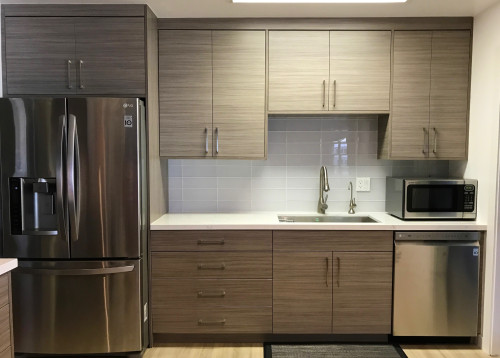
Mixing and Matching Cabinet Door Styles
Incorporating a combination of cabinet door styles in your kitchen design can create a unique and visually appealing space that reflects your personal style. In this section, we will discuss how to successfully mix and match cabinet door styles in your kitchen design.
A. Choosing Complementary Styles
When combining different cabinet door styles, it is essential to select styles that complement each other and contribute to a cohesive overall design. Consider the architectural elements and design style of your home when selecting door styles. For example, pairing slab cabinet doors with Shaker-style doors can create a balance between modern and traditional elements, resulting in a transitional design aesthetic.
B. Balancing Proportions
To maintain visual harmony, pay close attention to the proportions of each door style in your kitchen design. If you choose to incorporate multiple door styles, consider using a dominant style for the majority of your cabinetry and reserving the secondary style for accent or focal points. This can help prevent your kitchen from looking cluttered or disjointed.
C. Focusing on Functional Areas
Another effective approach for mixing and matching cabinet door styles is to designate specific functional areas within your kitchen. For example, you might use kitchen cabinet slab doors for your base cabinets and a more traditional raised panel door style for upper cabinets. Alternatively, consider using slab cabinet doors for your main kitchen cabinetry and a different style for an island or pantry area.
D. Coordinating Colors and Finishes
When combining different door styles, it is crucial to ensure that the colors and finishes complement each other. This may involve using the same color or finish for all cabinet doors or selecting coordinating shades and tones that create a harmonious color palette. Consider using a single, unifying element, such as the same hardware or countertop material, to tie the different door styles together visually.
E. Consulting with a Professional
Mixing and matching cabinet door styles can be a complex process that requires careful planning and consideration. If you are unsure how to successfully incorporate multiple door styles into your kitchen design, consider consulting with a professional kitchen designer. They can help you select the best door styles, finishes, and layout for your space, ensuring a cohesive and visually appealing result.
FAQs
- What are slab cabinet doors?
Slab cabinet doors are a type of cabinet door style featuring a single, flat panel without any raised or recessed detailing. They offer a sleek, minimalist design that is popular in modern and contemporary kitchens.
- Are slab cabinet doors and flat panel cabinet doors the same?
Yes, slab cabinet doors and flat panel cabinet doors are essentially the same. Both terms refer to a cabinet door style with a flat, unadorned panel.
- What materials are commonly used for slab kitchen doors?
Slab kitchen doors can be made from various materials, including solid wood, medium-density fiberboard (MDF), plywood, laminate, thermofoil, and veneer.
- What are the pros of slab kitchen cabinet doors?
The primary advantages of slab kitchen cabinet doors include their sleek, modern appearance, ease of cleaning, customization options, and suitability for small or minimalist spaces.
- What are the cons of slab door cabinets?
The main drawbacks of slab door cabinets include limited detailing options, potential for warping (depending on the material), higher cost for some materials, susceptibility to fingerprints and smudges, and potential for visible damage.
- How can I mix and match slab kitchen cabinet doors with other door styles?
To mix and match slab kitchen cabinet doors with other door styles, choose complementary styles, balance proportions, designate functional areas, coordinate colors and finishes, and consider consulting with a professional kitchen designer for guidance.
- What finishes are available for slab cabinet doors?
Slab cabinet doors can be finished in various ways, including painted, laminate, thermofoil, veneer, and stained finishes.
- How do I choose the right finish for my slab kitchen doors?
When selecting a finish for your slab kitchen doors, consider your aesthetic preferences, maintenance requirements, budget, and desired durability. It may also be helpful to consult with a professional kitchen designer or cabinet supplier for guidance.
- Can slab kitchen cabinet doors be used in traditional kitchen designs?
While slab kitchen cabinet doors are most commonly associated with modern and contemporary kitchens, they can be incorporated into traditional designs when paired with complementary elements, such as ornate hardware or other traditional door styles.
- How do I maintain and clean slab cabinet doors?
To maintain and clean slab cabinet doors, use a soft, damp cloth and mild cleaning solution to wipe down the surface as needed. Avoid using abrasive cleaners or scouring pads, as they may damage the finish. Additionally, ensure that the cabinet doors are properly sealed to protect against moisture and other environmental factors.


